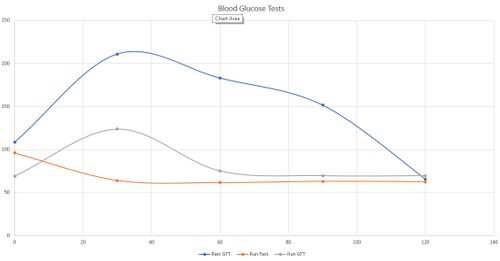Blood Glucose
Blood glucose can be tested quite easily and cheaply, and may provide some useful information for endurance runners.
Contents
1 Why test blood glucose
For runners who race marathon or ultramarathon distances it is important to optimize fueling. The human body stores carbohydrate as Glycogen in the muscles and liver, and the depletion of that glycogen can cause fatigue and impaired performance. A common pattern of blood glucose while exercising is for the level to rise during the first part of training as the body Warms up, then gradually declines until exhaustion. (The exhaustion can be caused by many different factors besides low blood sugar.) The level at which blood glucose starts to impact performance appears to be somewhat different for different individuals. For me, my performance often (but not always) suffers when my blood glucose drops below 100 mg/dl. If you know how your blood glucose impacts your performance you can then evaluate how effective your fueling is.
2 Glucose Tolerance Test
A Glucose Tolerance Test is typically used to diagnose diabetes, but it can provide some useful insight into both healthy and diabetic runners. I performed a number of tests to compare how my body uses glucose. I started with a standard GTT, in which I took 75g of Dextrose after an overnight fast and checked my blood glucose every 15 minutes for two hours. A GTT often just looks at the blood glucose level at the two-hour mark, but I was interested in the shape of the curve and the area under the curve. I then checked my blood glucose during a fasted long run to see how things go without any fueling. I was surprised my blood glucose was as low as it was given that I felt fine and was happy to carry on running for anther two hours after the test. I only checked blood glucose every 30 minutes as it requires slowing down to a walk to check, which interrupts the run. My third test was to take the 75g at the start of the long run and see how that compares. As you can see, my blood glucose rose at the three-hour mark, but nowhere near as high as when resting, and by the hour mark its back to baseline. This suggests that for me, under these conditions, 75g of dextrose will be consumed within 60 minutes. My next tests will be to take the glucose immediately before a short, hard interval session, then repeat it taking the glucose immediately after a similar interval session.
The results above can't be generalized to anyone else, and are provided as an example of how you can use blood glucose testing.
3 What's involved in testing?
The biggest downside to blood glucose testing is the need to prick your finger to draw blood. If you're doing the testing to gather data on your running, you're probably not going to be doing the test often enough for the discomfort to be a problem. The drop of blood goes onto a test strip that's inserted into a meter, which measures the chemical reaction between the glucose in the blood and the test strip, giving you a reading in a few seconds. The test strips are not reusable and the cost of the test strips works out far more than the cost of the meter.
4 Accuracy
Generally, blood glucose meters are accurate to +/- 20%. Normally glucose meters define their accuracy in terms of the percentage of samples that have a given error. For instance the TRUE2go meter has 55% of samples within 5%, 82% within 10%, 96% within 15% and 99.7% within 20%. What's that mean in practice? A single reading is good enough for clinical use, but for more rigorous use it's worth taking several reading and averaging them. For instance, averaging multiple samples improves the accuracy like this:
| Samples | Percent within +/-5% | Percent within +/-10% | Percent within +/-15% | Percent within +/-20% |
|---|---|---|---|---|
| 1 | 54.9% | 86.8% | 97.7% | 99.7% |
| 2 | 71.3% | 96.7% | 99.9% | 100% |
| 3 | 80.7% | 99.1% | 100% | 100% |
| 4 | 86.9% | 99.8% | 100% | 100% |
| 5 | 91% | 99.9% | 100% | 100% |
For instance, I recently took readings of 82, 88, 95 and 93. That first reading of 82 indicates the actual blood glucose is between 66 and 98, which is rather a wide range. The average of the four readings is 89.5, which is probably a little closer to reality. Taking just the first reading of 82 would have been quite misleading.
5 My Testing Technique
I've found a lot of variation between samples taken at the same time, which is frustrating. Taking two samples and averaging them helps, and if they're too far apart, take a third. I suspect it helps to draw a drop of blood, wipe it away and draw another drop for testing. Taking the test from a much larger drop of blood than the minimum required also seems to result in more repeatable readings. Obviously, ensuring your finger is clean is critical, as even a trace amount of sugar will corrupt the reading.
6 Which glucose meter?
I have tried a number of glucose meters, and found the Contour Next One is one of the best. It's cheap to buy and reasonably accurate.

| This review was made possible by readers like you buying products via my links. I buy all the products I review through normal retail channels, which allows me to create unbiased reviews free from the influence of reciprocity, or the need to keep vendors happy. It also ensures I don't get "reviewer specials" that are better than the retail versions.
|
7 Which Lancet?
Sticking yourself with a lancet to draw blood isn't a great experience. I read of the Lifescan Onetouch Delica and its "reduced vibration" which they claim reduces the pain. It's still not pain free, but it seems better than the other lancet devices I tried, and much better than the free devices that often come with the meters.

| This review was made possible by readers like you buying products via my links. I buy all the products I review through normal retail channels, which allows me to create unbiased reviews free from the influence of reciprocity, or the need to keep vendors happy. It also ensures I don't get "reviewer specials" that are better than the retail versions.
|
